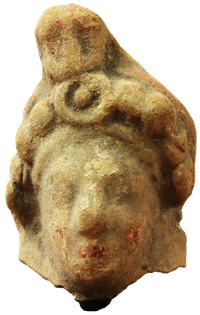Head of a symposiast with tiara
 |
Head of a symposiast with tiara, Inv. T I-39 Front from the mould, back concave, smoothed, not finished. Light brown (7.5YR 7/3-4) clay. Red painting on the tiara and lotus crown; dark red on the lips and cheeks. Provenance: Unknown. State of preservation: Break-off below the head. Injuries to the hair, bruises to the lower face and lotus flower. Dimensions: H: 5,5 cm; W: 3,6 cm; D: 2,4 cm. References: W. Wamser-Krasznai, Studien zu den Typen der Tarentiner Symposiasten (Diss. Justus- Liebig- Universität Gießen 2003) URL: http://geb.uni-giessen.de/geb/volltexte/2003/1184, 99. 126. 136f. 175 fig. 13.; W.Wamser-Krasznai, Für Götter gelagert (Budapest 2013), 93-96. |
Description: The central ornamental disc with a sculpted rim and raised centre, similar to an omphalos bowl, is shifted slightly to the right side of the head, an asymmetry that is further emphasised by the crowning lotus flower.
Small arches, presumably remnants of the original curls, are visible at the lower edge of the forehead hair. The strands of shoulder hair have been preserved on the left side. The elongated face tapers towards the chin. A large nose protrudes from the receding profile. Above slightly arched eyeballs, the brows form high arches. The shape of the small, horizontally cut mouth can only be deduced from the red painting.
Commentary: As comparative examples show, the beardless person depicted here, crowned with a spherical diadem, usually wears a cloak that covers the lower part of the body and falls as a triangular tip over the left arm. The bed consists of a simple high-legged kline which is imagined to be made of wood. A bowl[1] lies in the left slightly curved hand. According to the measurements of the head T I-39, the figure together with the kline might have been about 25 cm high.
In addition to the specific shape of the headdress[2], the width of the middle section of the face and the wide distance between the eyes[3] confirm that it belongs to a coroplast workshop in Taranto.
With its elongated face, the lines of which quickly transition backwards into the depths, the slight curvature of the eyeballs and the straight-cut small mouth, as well as the arch of hair reaching down to the ears, the head has crossed the threshold of the Early Classical period, as a close parallel in Karlsruhe[4] also shows.
Determination: Early 5th century BC, from Taranto
 |
 |
 |
|---|
[1] W. Schürmann, Katalog der antiken Terrakotten im Badischen Landesmuseum Karlsruhe (Göteborg 1989) 70 no. 218 pl. 38; W. Wamser-Krasznai, Studien zu den Typen der Tarentiner Symposiasten (Diss. Justus- Liebig- Universität Gießen 2003) URL: http://geb.uni-giessen.de/geb/volltexte/2003/1184, 145 no. 72 fig. 14; U. Hausmann, Italische Antiken. Zeugnisse der vorrömischen Kultur Italiens aus dem Besitz des Archäologischen Instituts der Universität Tübingen. Ausstellung Februar 1971, 61 no. 176; M. Borriello, L’Apulia. Taranto, in: St. De Caro – M. Borriello (eds.), La Magna Grecia nelle collezioni del Museo Archeologico di Napoli (Neapel 1996) 99, fig. 9.9.
[2] S. Besques, Figurines et reliefs grecs en terre cuite (Paris 1994) 82 fig. 66; C. Iacobone, Le stipi votive di Taranto (Rom 1988) 59 f. pl. 48 a. 49 a.
[3] W. Schürmann ibid. 69 f. no. 216-219 pl. 38.
[4] W. Schürmann ibid. 70 no. 218 pl. 38.
